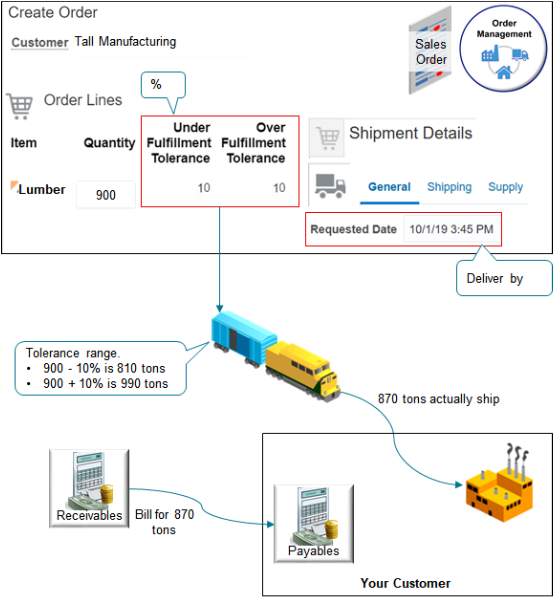Shipment Tolerances
Use shipment tolerances to help manage the variability in your supply chain that makes it difficult to fulfill an exact quantity on an order line on a specific date.
Use a tolerance to make sure you can ship the entire manufactured quantity to your customer, even if it exceeds the ordered quantity. Eliminate inventory carrying costs for the additional quantity and increase revenue. Reduce or eliminate the time you spend doing a manual workaround to manage order fulfillment, and, as a result, improve your customer's satisfaction.
Variability is inherent in some supply chains. For example:
-
Item attributes that affect fulfillment vary for instance of the item, such as weight, size, complexity, and so on.
-
Your item is prone to natural phenomena that you can't control or predict, such as fruit or produce that molds in the field if its too wet, dries out quickly if its too hot, or a percent of it spoils while held up in a queue during shipping when going through customs or an agriculture check.
-
Your supply source is inconsistent and constantly changing.
-
Your manufacturing process is complex and prone to widely variable failure rates.
-
The political environment or government policies affect your supply chain in a way that makes it hard to accurately predict when and where you will source material, how you build the item, the shipping channels that are available to you, and so on.
Example
Assume you work for Green Corp, a sustainable forestry products company that uses railroads to ship a bulk material, such as raw timber that you haven't kiln dried or milled. Your customer orders a quantity of 900 tons.

Note
-
You plan to ship the order on train cars that have a maximum capacity of 100 tons each.
-
You must reserve the cars weeks in advance, the railroad charges you for each car, so you prefer to fill them as close to capacity as possible. But there's a significant variation in the amount of lumber you can get on a single car because moisture content varies from season to season and year to year, and moisture content affects weight. Even the location where you source the lumber affects the weight of your product, such as the wet Pacific Northwest compared to the drier Rocky Mountains.
-
Given these factors, its nearly impossible to accurately and consistently predict weight or volume, so you arranged an agreement with your customer to deliver quantity within a range that you and your customer can tolerate.
-
The agreement is to ship with a 10% over shipment tolerance and 10% under shipment tolerance.
-
10% of 900 is 90, so you can ship between 810 tons (900 minus 90) and 990 tons (900 plus 90) and remain within the tolerance.
-
The actual shipment ends up being 870 tons during fulfillment, which is an undershipment. Billing bills the customer for 870 tons.